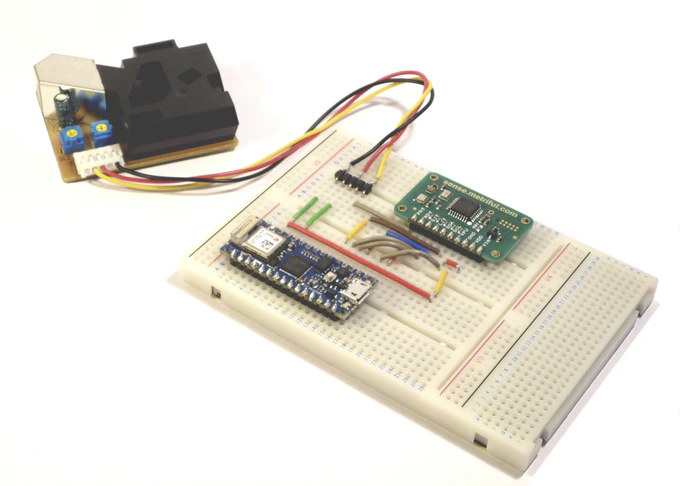Even before the COVID-19 lockdown, people spent most of their time indoors (around 90% according to some studies), so it’s important to monitor air quality and other metrics like light and sound levels in our homes, workplaces, schools, cars, etc…
Metriful Sense indoor environment monitor does just that by reporting multiple metrics such as temperature, humidity, particle concentration, etc… over I2C to microcontroller or processor boards such as Arduino or Raspberry Pi.
Sense hardware specifications:
- MCU – STMicro STM32G071KB Arm Cortex-M0+ microcontroller @ 64 MHz with 128 KB Flash, 36 KB SRAM
- Sensors
- I/Os – 10-pin unpopulated header with air particles sensor input, light and sound interrupt outputs, I2C, VPU pin for 3.3V/5V selection, GND, VDD, VIN and RDY (EEADY signal output)
- Supply Voltage – 3.3V (VDD) or 3.6V to 6V with VIN
- Dimensions – 37.5 x 23.4 x 3.1 mm

Environmental data is stored in 16 STM32 registers for temperature, pressure, relative humidity, gas sensor resistance, Air quality index (AQI) & AQI accuracy, estimated CO2 concentration, equivalent breath VOC concentration, Illuminance, white light, A-weighted sound pressure level, sound
pressure level (frequency bands), peak sound amplitude, sound measurement stability, particle sensor occupancy, and particle concentration.
The board can be used for home automation, Internet of Things (IoT), and “context awareness” applications where data is used for machine learning and pattern recognition. The company provides documentation and samples for Arduino and Raspberry Pi boards on Github. The instructions also include connection to IoT cloud services such as Tago cloud or ThingSpeak.
Metriful Sense indoor environment monitor has launched on Kickstarter and already easily surpassed its lowly $379 funding goal. The board is offered for 31 GBP (~$40 US) without header, or 34 GBP ($44) with a 10-pin header soldered. There’s no option for PPD42 particle sensor, so you’d have to purchase separately for example on Aliexpress ($7.20 plus shipping). Untracked shipping is included in the price, but they’ll only ship to a limited number of countries/regions: USA, EU, UK, Canada, Norway, Switzerland, Australia, New Zealand, Singapore, Japan. You’ll need to add 6 GBP if you prefer to have a tracking number. Rewards are expected to be delivered in September 2020.
More details may also be found on the company’s website.
Via LinuxGizmos

Jean-Luc started CNX Software in 2010 as a part-time endeavor, before quitting his job as a software engineering manager, and starting to write daily news, and reviews full time later in 2011.
Support CNX Software! Donate via cryptocurrencies, become a Patron on Patreon, or purchase goods on Amazon or Aliexpress







Bit annoying there’s no SPI interface for local SD card logging of data, or external flash (128K won’t go very far)
LOL. Thats why its called Kickstarter, its not a refined interated mature product that consumers adore, its gotta be kick-started. A tease nevertheless but for some esp educational markets, its enough.
There’s plenty of RAM (up to 8 GB) on RPi 4 board. You can start two processes, each with 3 GB of userspace RAM, and finally store to SD when the memory buffer is full, to minimize SD wear.
You have a particularly strange way of wasting available resources, Jerry, I’d never want to have you as a developer on any project I use. Using 6G RAM to store a few variables isn’t that common even in lazy languages. And you’d note that with your approach, the time it takes to fill them with so few input rate far outlasts the board’s life, resulting in your data never hitting the SD at all and being lost on every reboot.
The marketer’s old problem: the company has a ‘solution’ (something with 8GB of RAM) needing a ‘problem’.
BTW: Write Amplification and as such wear on SD card when writing 16KiB chunks as opposed to 3GB chunks is the same. No moronic buffering that huge needed.
Would be more interesting with Sensirion, Amphenol or Honeywell PM2.5 particle counters.
They say they’re also checking compatibility with the SDS011 particle sensor, which would be good because it’s much better than the PPD42.
> people spent most of their time indoors, so it’s important to monitor…
Huh? Just spend more time outdoors. Especially important for kids! Your health and overall well-being will benefit.
When I realised it had an ‘input for particulate sensor’ it became obvious it’s just another weather module being marketed for indoors. Move on, nothing to see here…